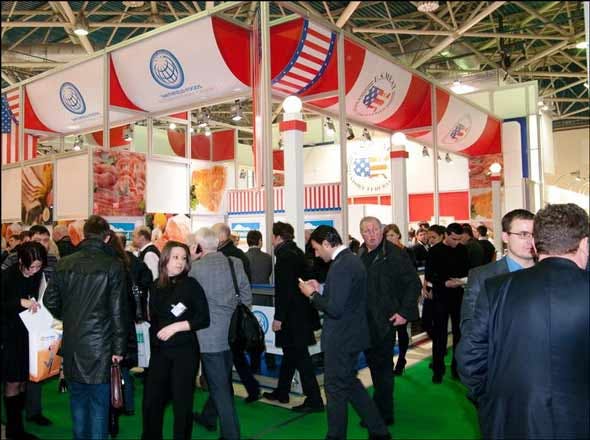Growth Opportunities for U.S. Pork, Beef Explored at Prodexpo in Moscow
Published: Mar 07, 2012
Now in its 19th year, Prodexpo is one of the largest annual trade shows for food and beverage suppliers looking to expand their business in Russia and Eastern Europe. Prodexpo 2012 was recently held in Moscow, with about 2,100 companies exhibiting products and services to more than 60,000 attendees over five days.

With support from the USDA Market Access Program (MAP) and the Pork Checkoff and Beef Checkoff Programs, USMEF has a well-established presence at Prodexpo, exhibiting for the 14th time in 2012. This year’s event drew a strong turnout of participating U.S. suppliers, exporters and traders.
“These are exciting economic times in this region, with Russia not only joining the World Trade Organization but also developing a customs union with some of its neighboring economies,” said John Brook, USMEF regional director for Europe, Russia and the Middle East. “Opportunities are expanding for red meat imports, and our goal is to help U.S. companies capitalize on this situation and grow their business presence here. Prodexpo is an excellent venue for showcasing U.S. red meat quality, safety and other attributes that make it attractive to Russian consumers.”
USMEF held a meat showcase and tasting demonstration to highlight new beef brands and products, introduce new packaging and merchandising techniques and familiarize buyers with underutilized cuts of pork, beef and veal. USMEF also hosted its annual Prodexpo reception honoring participating U.S. processors and exporters, which provided an informal setting for networking with buyers, retailers and distributors from throughout the region.

Another major highlight of the event was a visit to the USMEF booth by U.S. Ambassador to Russia Michael McFaul. He was joined by FAS Minister-Counselor Scott Reynolds and specialists from the Agricultural Trade Office in Moscow.
“I spent most of my time (at Prodexpo) speaking with American firms that export and facilitate exports of poultry, pork and beef to Russia,” said Ambassador McFaul on the U.S. Embassy website. “I was struck by how well our companies do here despite a very competitive international environment. Our strong sales here in Russia demonstrate a strong and sustained demand for American goods.”
McFaul also heard firsthand from exporters about some of the ongoing challenges they face in the Russian market. “Exporters continue to struggle with non-tariff barriers, especially sanitary and phytosanitary restrictions that appear at times to be arbitrary and lacking a scientific justification,” he said “We hope that Russia’s membership into the WTO will help to provide international standards and a dispute mechanism for regulating these kinds of concerns. A level and transparent playing field is all our companies want to see.”
U.S. beef exports posted a record-shattering year in Russia in 2011, reaching 72,797 metric tons or 160.4 million pounds (all totals include both muscle cuts and variety meat). This broke the previous volume record set in 2002, when Russia accepted beef from cattle of all ages but was mostly a market for livers and other variety meat. The 2011 value total of $255.6 million broke the previous record (set in 2010) by a whopping 68 percent. A higher tariff rate quota for muscle cuts offers strong prospects for further growth in 2012. Last year’s quota was 41,700 metric tons, but Russia has agreed to increase it to 60,000 metric tons this year.
Pork exports to Russia slipped by 17 percent in volume (74,247 metric tons or 163.7 million pounds) in 2011 but still managed a 5 percent increase in value to $230 million. For 2012, Russia has eliminated the country-specific quota that was open only to U.S. pork. This is actually a positive development, however, because now the United States can participate in the 400,000 metric ton quota that is open to all countries – an arrangement that should offer greater growth potential. Russia’s in-quota tariff rate for pork will remain 15 percent for most of this year, but is scheduled for elimination when Russia’s WTO accession terms are implemented.
